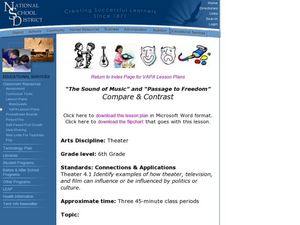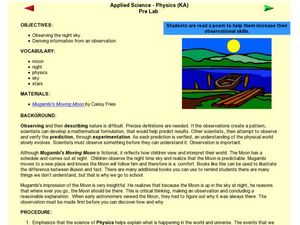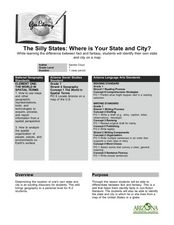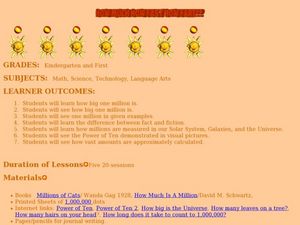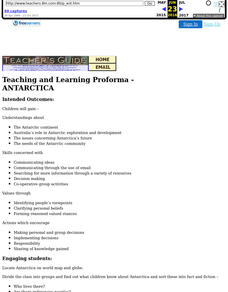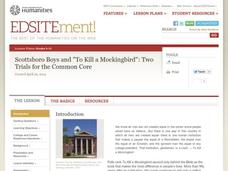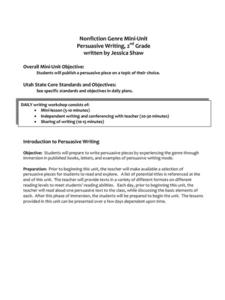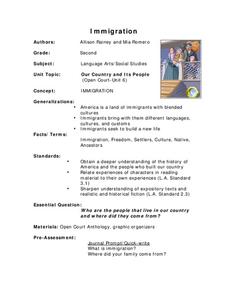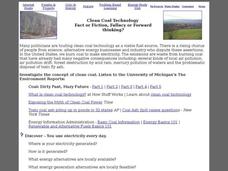Curated OER
Dinosaurs - Physical Characteristics
Pupils describe the physical characteristics of dinosaurs, compare and contrast the evolution of land, and they explore the extinction of dinosaurs.
Curated OER
The Crucible: Hysteria, Witches and Death
Eleventh graders explore the historical events of the Salem witch trials. After completing research and reading a play on the witch trials, 11th graders compare and contrast the historical facts to the fictional play. In groups, students...
Curated OER
The Sound of Music and Passage to Freedom
Seventh graders examine music examples to investigate a conflict in history about Hitler's invasions during WWII. In this music analysis lesson plan, 7th graders discuss vocabulary and the history for the Holocaust and Hitler's...
Curated OER
A MATTER OF PERSPECTIVE: COLUMBUS IN THE NEW WORLD
Eighth graders study the famous explorer Christopher Columbus. In this World History lesson plan, 8th graders analyze and compare primary and secondary sources. Students discuss as a class the accomplishments of Columbus....
Curated OER
Poetry and Observations
Students compare poetry and the night sky. In this poetry lesson, students read poetry and compare the imagery from the poem with the night sky. Students explore how science and poetry relate to one another.
Curated OER
Report Writing in Primary Grades
Students learn how to read a short section and parepare a sentence to share with the group. Students listen to the reading of expository text, restate, in sentence format, one fact learned from that text, and produce a report.
Curated OER
Social Studies: Heroes in American Culture
Students examine heroes and discuss their characteristics, values, and actions. They produce Powerpoint presentations on real-life and fictional heroes. Students interview veterans for an oral history project.
Curated OER
Choice Not Chance
Students examine diets from another country and compare it to the US Food Guide Pyramid. They study the effect the diet has on an individual's health.
Curated OER
Let's Sum it Up
Students review facts previously discussed about snakes and lizards and read pages in their science text book about snakes and lizards silently focusing on remembering important facts. They then complete a Venn diagram comparing snakes...
Curated OER
The Silly States: Where Is Your State and City?
First graders read The Scrambled States of America and discuss whether it is real or fantasy as compared to the United States. In this geography lesson, 1st graders identify their city or state on a map and work in groups to color the...
Curated OER
Exploring the Neighborhood -- Literature Jigsaw
Students compare and contrast domesticated animals and wild animals. They identify plants and animals that have adapted to different habitats. They discover it is everyone's responsibility to protect the environment.
Curated OER
"Anything We Love Can Be Saved" -- A Contemporary
High schoolers compare authors Rachel Carson and Mary Eliza Church Terrell. They read an introduction by Alice Walker and summarize the main points. They also identify the language she uses to persuade readers. They write their own...
Curated OER
How Much, How Fast, How Far?
Students investigate the concept of the number one million. In this number concepts lesson, students read the book How Much is a Million? and brainstorm questions, such as "how many leaves are on a tree" and "how many hairs are on your...
Curated OER
The Stock Market: Risks & Rewards
In order to better understand the US economy, learners read and interpret stock market price reports. They define profits and explain the role of profits in the American economic system for both firms and individual investors. Several...
Curated OER
Antarctica
Students explore the Antarctic continent, Australia's role in Antarctic exploration and development, the issues concerning Antarctica's future and the needs of the Antarctic community.
Curated OER
Trash! How Cities Work: Dealing with Garbage in the US and India
Students identify how different cultures deal with the challenge of trash. Read an excerpt from a chapter book based on real life written from the Southern Indian perspective. Describe the life of a street child in Southern India....
Curated OER
Native American Heritage Month
An exploration of Native American culture can lead to art, literature, and poetry activities.
National Endowment for the Humanities
Scottsboro Boys and "To Kill a Mockingbird": Two Trials for the Common Core
Here's a must-have resource for anyone reading To Kill A Mockingbird or using Harper Lee's award-winning novel in a classroom. The packet contains Miss Hollace Ransdall's first-hand, factual account of the trials of the Scottsboro Boys,...
Curated OER
"Spelldown" by Becky Mushko
Learners read Spelldown, by Becky Mushko and consider how it portrays the Appalachian community. They define and discuss vocabulary presented in the story and write a comparison/contrast paper analyzing two of the story's characters. The...
Curated OER
Nonfiction Genre Mini-Unit: Persuasive Writing
Should primary graders have their own computers? Should animals be kept in captivity? Young writers learn how to develop and support a claim in this short unit on persuasive writing.
Curated OER
Immigration
Second graders read about immigration from their text. They select one culture and identify characteristics of the group. Students complete a graphic organizer (included with the lesson plan). They recall and list various aspects of...
Curated OER
Clean Coal Technology
In this clean coal worksheet, students click on the links to learn more about clean coal technology and answer short answer questions about it. Students complete 12 questions total.
Teacher Vision
The First Thanksgiving - Pilgrim Study Unit
Students explain the origins of Thanksgiving. As a class, they list all the meanings, stories, and images that come into their minds when they hear the word "Thanksgiving." After reading about Thanksgiving, pairs of students create 4...
Curated OER
Lots of Lessons from Aesop
Aesop’s Fables offer young learners an opportunity to study figurative language. After reviewing theme, simile, alliteration, and metaphor, model for your pupils how to identify examples of these devices in the fable. Class members then...


